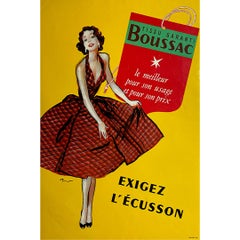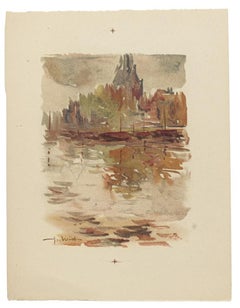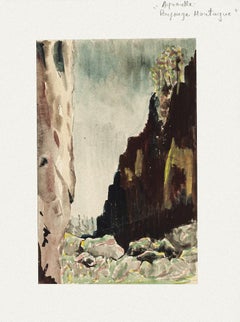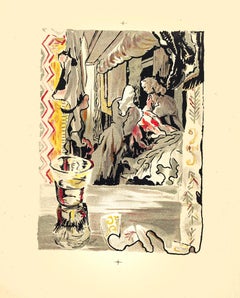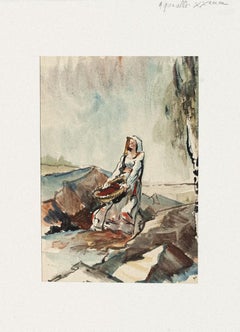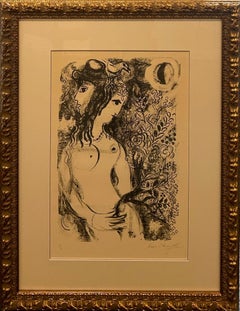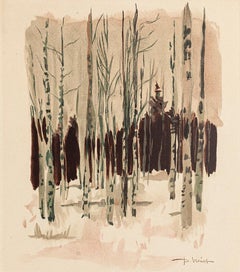Pierre Laurent Brenot Art
French, 1913-1998
Pierre-Laurent Brenot was a French artist that had specialized in figurative art. Many of his pieces focused on the most fashionable and decadent aspects of upper-class life. His figures are often depicted as greatly enjoying whatever pleasures of life they can. Sometimes, Brenot also made pinup artworks featuring idealized women in scandalous situations.
to
2
10
1
11
9
1
1
Overall Height
to
Overall Width
to
2
11
10
7
2
2
2
1
1
1
1
1
1
1
1
11
1
1
11
6,909
3,250
2,514
1,217
7
7
4
1
Artist: Pierre Laurent Brenot
Original poster created in 1953 by Brenot to promote the famous Boussac fabric
By Pierre Laurent Brenot
Located in PARIS, FR
Original poster created in 1953 by Brenot to promote the famous Boussac fabric.
A respected captain of industry, Marcel Boussac was an extraordinary personality who rose to fame and...
Category
1950s Pierre Laurent Brenot Art
Materials
Paper, Lithograph
Landscape - Watercolor on Paper by Pierre Laurent Brenot - Mid-20th Century
By Pierre Laurent Brenot
Located in Roma, IT
Landscape is an original watercolor realized by Pierre Laurent Brenot (1913-1998).
Good conditions, aged and good except for some folding along the margins.
Here the artwork repres...
Category
Mid-20th Century Pierre Laurent Brenot Art
Materials
Watercolor
Valley - Watercolor on Paper by Pierre Laurent Brenot - Mid-20th Century
By Pierre Laurent Brenot
Located in Roma, IT
Valley is a watercolor on paper realized by Pierre Laurent Brenot (1913-1998).
Good conditions, aged.
Passepartout included: 32 x 24.
Here the artwork represents a valley in vivid colors. The artwork is depicted skillfully through confident and soft strokes in a well-balanced composition and harmonious colors.
Pierre-Laurent Brenot (1913-1998) In 1928, he entered the École Estienne where he attended classes for three years. Then he continued his training as a designer with Fernand Hertenberger. Pierre-Laurent Brenot's gifts of observation and precision in his pencil stroke were immediately noticed.During the fashion years (from 1936 to 1950),he was hired by Monsieur Chatard, a great tailor for men and women, in his Fashionable store, at number 16 boulevard Montmartre. He then created a line of men's suits. On his momentum, he produced numerous fashion designs for other great couturiers (Christian Dior, Jacques Fath, Cristóbal Balenciaga, Nina Ricci, Jeanne Lafaurie...
Category
Mid-20th Century Pierre Laurent Brenot Art
Materials
Watercolor
Women - Lithograph on Paper by Pierre Laurent Brenot - Mid-20th Century
By Pierre Laurent Brenot
Located in Roma, IT
Women is a lithograph on paper realized by Pierre Laurent Brenot (1913-1998).
Good conditions, aged and good except for some folding along the margins.
Here the artwork represents two women talking in vivid colors. The artwork is depicted skillfully through confident and soft strokes in a well-balanced composition and harmonious colors.
Pierre-Laurent Brenot (1913-1998) In 1928, he entered the École Estienne where he attended classes for three years. Then he continued his training as a designer with Fernand Hertenberger. Pierre-Laurent Brenot's gifts of observation and precision in his pencil stroke were immediately noticed.During the fashion years (from 1936 to 1950),he was hired by Monsieur Chatard, a great tailor for men and women, in his Fashionable store, at number 16 boulevard Montmartre. He then created a line of men's suits. On his momentum, he produced numerous fashion designs for other great couturiers (Christian Dior, Jacques Fath, Cristóbal Balenciaga, Nina Ricci, Jeanne Lafaurie...
Category
Mid-20th Century Modern Pierre Laurent Brenot Art
Materials
Lithograph
Sympathy - Watercolor on Paper by Pierre Laurent Brenot - Mid-20th Century
By Pierre Laurent Brenot
Located in Roma, IT
Sympathy is a watercolor on paper realized by Pierre Laurent Brenot (1913-1998)
Good conditions, aged.
included the Passepartout: 32 x 24.
Here the artwork represents a man on h...
Category
Mid-20th Century Pierre Laurent Brenot Art
Materials
Watercolor
Woman - Watercolor on Paper by Pierre Laurent Brenot - Mid-20th Century
By Pierre Laurent Brenot
Located in Roma, IT
Woman is a watercolor on paper artwork realized by Pierre Laurent Brenot (1913-1998).
Good conditions, aged.
Passepartout included: 32 x 24.
Here the artwork represents a woman carrying a basket in vivid colors. The artwork is depicted skillfully through confident and soft strokes in a well-balanced composition and harmonious colors.
Pierre-Laurent Brenot (1913-1998) In 1928, he entered the École Estienne where he attended classes for three years. Then he continued his training as a designer with Fernand Hertenberger. Pierre-Laurent Brenot's gifts of observation and precision in his pencil stroke were immediately noticed.During the fashion years (from 1936 to 1950),he was hired by Monsieur Chatard, a great tailor for men and women, in his Fashionable store, at number 16 boulevard Montmartre. He then created a line of men's suits. On his momentum, he produced numerous fashion designs for other great couturiers (Christian Dior, Jacques Fath, Cristóbal Balenciaga, Nina Ricci, Jeanne Lafaurie...
Category
Mid-20th Century Pierre Laurent Brenot Art
Materials
Watercolor
Rider - Watercolor on Paper by Pierre Laurent Brenot - 20th Century
By Pierre Laurent Brenot
Located in Roma, IT
Rider is a watercolor on paper realized by Pierre Laurent Brenot (1913-1998).
Good conditions, aged.
Passepartout included: 32 x 24.
Here the artwork represents a rider coming forward. vivid colors. The artwork is depicted skillfully through confident and soft strokes in a well-balanced composition and harmonious colors.
Pierre-Laurent Brenot (1913-1998) In 1928, he entered the École Estienne where he attended classes for three years. Then he continued his training as a designer with Fernand Hertenberger. Pierre-Laurent Brenot's gifts of observation and precision in his pencil stroke were immediately noticed.During the fashion years (from 1936 to 1950),he was hired by Monsieur Chatard, a great tailor for men and women, in his Fashionable store, at number 16 boulevard Montmartre. He then created a line of men's suits. On his momentum, he produced numerous fashion designs for other great couturiers (Christian Dior, Jacques Fath, Cristóbal Balenciaga, Nina Ricci, Jeanne Lafaurie...
Category
Mid-20th Century Pierre Laurent Brenot Art
Materials
Watercolor
Interior with Woman - Watercolor on Paper by P. L. Brenot - Mid-20th Century
By Pierre Laurent Brenot
Located in Roma, IT
Woman is a watercolor on paper realized by Pierre Laurent Brenot (1913-1998).
Good conditions, aged, except some traces of humidity around the margins that don't affect the image.
Here the artwork represents a woman in vivid colors. The artwork is depicted skillfully through confident and soft strokes in a well-balanced composition and harmonious colors.
Pierre-Laurent Brenot (1913-1998) In 1928, he entered the École Estienne where he attended classes for three years. Then he continued his training as a designer with Fernand Hertenberger. Pierre-Laurent Brenot's gifts of observation and precision in his pencil stroke were immediately noticed.During the fashion years (from 1936 to 1950),he was hired by Monsieur Chatard, a great tailor for men and women, in his Fashionable store, at number 16 boulevard Montmartre. He then created a line of men's suits. On his momentum, he produced numerous fashion designs for other great couturiers (Christian Dior, Jacques Fath, Cristóbal Balenciaga, Nina Ricci, Jeanne Lafaurie...
Category
Mid-20th Century Pierre Laurent Brenot Art
Materials
Watercolor
Sympathy - Watercolor on Paper by Pierre Laurent Brenot - Mid-20th Century
By Pierre Laurent Brenot
Located in Roma, IT
Sympathy is a watercolor on paper realized by Pierre Laurent Brenot (1913-1998).
Good conditions, aged.
Included the Passepartout: 32 x 24.
There is the lithograph of the same artwork included: 18.4 x 14.
Here the artwork represents a couple sitting together in a candlelight. The artwork is depicted skillfully through confident and soft strokes in a well-balanced composition and harmonious colors.
Pierre-Laurent Brenot (1913-1998) In 1928, he entered the École Estienne where he attended classes for three years. Then he continued his training as a designer with Fernand Hertenberger. Pierre-Laurent Brenot's gifts of observation and precision in his pencil stroke were immediately noticed.During the fashion years (from 1936 to 1950),he was hired by Monsieur Chatard, a great tailor for men and women, in his Fashionable store, at number 16 boulevard Montmartre. He then created a line of men's suits. On his momentum, he produced numerous fashion designs for other great couturiers (Christian Dior, Jacques Fath, Cristóbal Balenciaga, Nina Ricci, Jeanne Lafaurie...
Category
Mid-20th Century Modern Pierre Laurent Brenot Art
Materials
Watercolor
Woman - Original Lithograph on Paper by Pierre Laurent Brenot - 20th Century
By Pierre Laurent Brenot
Located in Roma, IT
Woman is an original lithograph on paper realized by Pierre Laurent Brenot (1913-1998).
Good conditions, aged and good except for some folding along the margins.
Here the artwork represents a woman in vivid colors. The artwork is depicted skillfully through confident and soft strokes in a well-balanced composition and harmonious colors.
Pierre-Laurent Brenot (1913-1998) In 1928, he entered the École Estienne where he attended classes for three years. Then he continued his training as a designer with Fernand Hertenberger. Pierre-Laurent Brenot's gifts of observation and precision in his pencil stroke were immediately noticed.During the fashion years (from 1936 to 1950),he was hired by Monsieur Chatard, a great tailor for men and women, in his Fashionable store, at number 16 boulevard Montmartre. He then created a line of men's suits. On his momentum, he produced numerous fashion designs for other great couturiers (Christian Dior, Jacques Fath, Cristóbal Balenciaga, Nina Ricci, Jeanne Lafaurie...
Category
20th Century Pierre Laurent Brenot Art
Materials
Lithograph
"Fashionable Boulevard Montmartre, " Original Lithograph Poster by Pierre Brenot
By Pierre Laurent Brenot
Located in Milwaukee, WI
"Fashionable Boulevard Montmartre" is an original lithograph poster by Pierre Laurent Brenot. This piece depicts four figures in fashionable costumes in a variety of dynamic poses. T...
Category
1940s Art Nouveau Pierre Laurent Brenot Art
Materials
Lithograph
Related Items
Signed 1960s Jean DUBUFFET print (Jean Dubuffet exhibition poster)
By Jean Dubuffet
Located in NEW YORK, NY
Jean Dubuffet Ustensiles Utopiques 1966:
Hand-signed Jean Dubuffet lithographic poster published on the occasion of: "Jean Dubuffet, Recent Pa...
Category
1960s Contemporary Pierre Laurent Brenot Art
Materials
Offset, Laid Paper, Lithograph
Signed Black and White Lithograph 'Couple a l’Oiseau' (Couple with a Bird)
By Marc Chagall
Located in Toronto, CA
Couple a l’Oiseau (Couple with a Bird). Black and white lithograph on Arches paper created in 1959 by Marc Chagall, printed by Mourlot in Paris. Signed and numbered in pencil by the ...
Category
1950s Fauvist Pierre Laurent Brenot Art
Materials
Paper, Lithograph
The Abduction of the Sabine Women , a Renaissance drawing by Biagio Pupini
Located in PARIS, FR
This vigorous drawing has long been attributed to Polidoro da Caravaggio: The Abduction of the Sabine Women is one of the scenes that Polidoro depicted between 1525 and 1527 on the façade of the Milesi Palazzo in Rome. However, the proximity to another drawing inspired by this same façade, kept at the Ecole des Beaux-Arts, and to other drawings inspired by Polidoro kept at the Musée du Louvre, leads us to propose an attribution to Biagio Pupini, a Bolognese artist whose life remains barely known, despite the abundant number of drawings attributed to him.
1. Biagio Pupini, a Bolognese artist in the light of the Roman Renaissance
The early life of Biagio Pupini, an important figure of the first half of the Cinquecento in Bologna - Vasari mentions him several times - is still poorly known. Neither his date of birth (probably around 1490-1495) nor his training are known. He is said to have been a pupil of Francesco Francia (1450 - 1517) and his name appears for the first time in 1511 in a contract with the painter Bagnacavallo (c. 1484 - 1542) for the frescoes of a church in Faenza. He then collaborated with Girolamo da Carpi, at San Michele in Bosco and at the villa of Belriguardo.
He must have gone to Rome for the first time with Bagnacavallo between 1511 and 1519. There he discovered the art of Raphael, with whom he might have worked, and that of Polidoro da Caravaggio. This first visit, and those that followed, were the occasion for an intense study of ancient and modern art, as illustrated by his abundant graphic production.
Polidoro da Caravaggio had a particular influence on the technique adopted by Pupini. Executed on coloured paper, his drawings generally combine pen, brown ink and wash with abundant highlights of white gouache, as in the drawing presented here.
2. The Abduction of the Sabine Women
Our drawing is an adaptation of a fresco painted between 1525 and 1527 by Polidoro da Caravaggio on the façade of the Milesi Palace in Rome. These painted façades were very famous from the moment they were painted and inspired many artists during their stay in Rome. These frescoes are now very deteriorated and difficult to see, as the palace is in a rather narrow street.
The episode of the abduction of the Sabine women (which appears in the centre of the photo above) is a historical theme that goes back to the origins of Rome and is recounted both by Titus Livius (Ab Urbe condita I,13), by Ovid (Fasti III, 199-228) and by Plutarch (II, Romulus 14-19). After killing his twin brother Romus, Romulus populates the city of Rome by opening it up to refugees and brigands and finds himself with an excess of men. Because of their reputation, none of the inhabitants of the neighbouring cities want to give them their daughters in marriage. The Romans then decide to invite their Sabine neighbours to a great feast during which they slaughter the Sabines and kidnap their daughters.
The engraving made by Giovanni Battista Gallestruzzi (1618 - 1677) around 1656-1658 gives us a good understanding of the Polidoro fresco, allowing us to see how Biagio Pupini reworked the scene to extract this dynamic group.
With a remarkable economy of means, Biagio Pupini takes over the left-hand side of the fresco and depicts in a very dense space two main groups, each consisting of a Roman and a Sabine, completed by a group of three soldiers in the background (which seems to differ quite significantly from Polidoro's composition).
The balance of the drawing is based on a very strongly structured composition. The drawing is organised around a median vertical axis, which runs along both the elbow of the kidnapped Sabine on the left and the foot of her captor, and the two main diagonals, reinforced by four secondary diagonals. This diamond-shaped structure creates an extremely dynamic space, in which centripetal movements (the legs of the Sabine on the right, the arm of the soldier on the back at the top right) and centrifugal movements (the arm of the kidnapper on the left and the legs of the Sabine he is carrying away, the arm of the Sabine on the right) oppose each other, giving the drawing the appearance of a whirlpool around a central point of support situated slightly to the left of the navel of the kidnapper on the right.
3. Polidoro da Caravaggio, and the decorations of Roman palaces
Polidoro da Caravaggio was a paradoxical artist who entered Raphael's (1483 - 1520) workshop at a very young age, when he oversaw the Lodges in the Vatican. Most of his Roman work, which was the peak of his career, has disappeared, as he specialised in facade painting, and yet these paintings, which are eminently visible in urban spaces, have influenced generations of artists who copied them abundantly during their visits to Rome.
Polidoro Caldara was born in Caravaggio around 1495-1500 (the birthplace of Michelangelo Merisi, known as Caravaggio, who was born there in 1571), some forty kilometres east of Milan. According to Vasari, he arrived as a mason on the Vatican's construction site and joined Raphael's workshop around 1517 (at the age of eighteen according to Vasari). This integration would have allowed Polidoro to work not only on the frescoes of the Lodges, but also on some of the frescoes of the Chambers, as well as on the flat of Cardinal Bibiena in the Vatican.
After Raphael's death in 1520, Polidoro worked first with Perin del Vaga before joining forces with Maturino of Florence (1490 - 1528), whom he had also known in Raphael's workshop. Together they specialised in the painting of palace façades. They were to produce some forty façades decorated with grisaille paintings imitating antique bas-reliefs.
The Sack of Rome in 1527, during which his friend Maturino was killed, led Polidoro to flee first to Naples (where he had already stayed in 1523), then to Messina. It was while he was preparing his return to the peninsula that he was murdered by one of his assistants, Tonno Calabrese, in 1543.
In his Vite, Vasari celebrated Polidoro as the greatest façade decorator of his time, noting that "there is no flat, palace, garden or villa in Rome that does not contain a work by Polidoro". Polidoro's facade decorations, most of which have disappeared as they were displayed in the open air, constitute the most important lost chapter of Roman art of the Cinquecento. The few surviving drawings of the painter can, however, give an idea of the original appearance of his murals and show that he was an artist of remarkable and highly original genius.
4. The façade of the Milesi Palace
Giovanni Antonio Milesi, who commissioned this palace, located not far from the Tiber, north of Piazza Navona, was a native of the Bergamo area, like Polidoro, with whom he maintained close friendly ties. Executed in the last years before the Sack of Rome, around 1526-1527, the decoration of Palazzo Milesi is considered Polidoro's greatest decorative success.
An engraving by Ernesto Maccari made at the end of the nineteenth century allows us to understand the general balance of this façade, which was still well preserved at the time. The frescoes were not entirely monochrome, but alternated elements in chiaroscuro simulating marble bas-reliefs and those in ochre simulating bronze and gold vases...
Category
16th Century Old Masters Pierre Laurent Brenot Art
Materials
Ink, Gouache, Pen
Sling-Shots Lit #3
By Robert Rauschenberg
Located in Washington Depot,, CT
lithograph & screenprint on paper & assemblage with Sailcloth, Mylar, Wooden lightbox, fluorescent fixture, aluminum moveable window shade system and Plexiglas
Ed. 23/25
Category
1980s Abstract Expressionist Pierre Laurent Brenot Art
Materials
Mylar, Plexiglass, Wood, Paper, Sailcloth, Lights, Lithograph, Screen
Discussion
By Thomas Hart Benton
Located in London, GB
A fine impression with large full margins published by Associated American Artists.
Category
1930s American Modern Pierre Laurent Brenot Art
Materials
Lithograph
Who needs a mammoth - Book illustration, Polish artist, Watercolor painting
By Joanna Rusinek
Located in Warsaw, PL
Illustration for book by Agnieszka Frączek 'Who needs a mammoth'
JOANNA RUSINEK
Printmaker, illustrator of children's books, author of press ill...
Category
2010s Contemporary Pierre Laurent Brenot Art
Materials
Paper, Watercolor, Pencil
Prodigal Son
By Thomas Hart Benton
Located in London, GB
A fine impression with full margins published by Associated American Artists with their information label present - pictured in Art and Popular Religion in Evangelical America, 1815-...
Category
1930s American Modern Pierre Laurent Brenot Art
Materials
Lithograph
Homme barbu couronné feuilles de vigne
By Pablo Picasso
Located in Palo Alto, CA
Created in 1962, this linocut on Arches wove paper is hand-signed by Pablo Picasso (Malaga, 1881 - Mougins, 1973) in pencil in the lower right margin and is numbered from the edition of 50 in the lower left margin.
Catalogue Raisonné:
Pablo Picasso Homme barbu couronné feuilles de vigne...
Category
1960s Modern Pierre Laurent Brenot Art
Materials
Lithograph
Gustav Melcher ( German, 1898 -?) Boats off Venice Italy Ink Water Color c. 1918
By Gustav Melcher
Located in Meinisberg, CH
Gustav Melcher
(German, 1898-?)
Segelschiffe vor Venedig - Sailing ships off Venice
• India ink, water colour wash
• Visible image ca. 11.5 x 18 cm
• Glased Frame ca. 20 x 25 cm
• Verso various inscriptions
• Signed lower right
Gustav Melcher was a German painter and a pioneer in film, film criticism and film theory and created this clever little picture of the skyline of Venice with various vessels.
Going by the various inscriptions an the backing paper, this drawing was made in 1918 when Gustav was twenty years old and passed on three years later to Gertrud Melcher on the 1. 2. 1921. I have no reasons to doubt this information. The small drawing is still in its unopened frame, so maybe there is more information to be discovered , however this will be the privilege of the next owner.
The picture also has retained its original antique frame – note that it has lost over the years various sections of the gesso decoration.
The very precisely executed drawing is most enjoyable to look at and doing so, remember you are looking through the eyes of a young man, who saw this foreign sea cape over a century ago.
Thank you for your interest and please note, that I offer free worldwide shipping on all my items.
Gustav Melcher began his studies at the Düsseldorfer Kunstakademie under Peter Janssen and Eduard von Gebhardt. Originaly he was interested in figurative and portrait painting, but after time he decided to pursue the depiction of land- and marinescapes. Durin his studies the young artist undertook trips to visit England, Scotland, Belgium and France and he joined the artist society Malkasten. It was in those days he would hold speeches to his colleges about this new invention called ‘Kintopp’ – Melcher was a great advocate of the moving pictures...
Category
1910s Naturalistic Pierre Laurent Brenot Art
Materials
India Ink, Paper, Watercolor
Gustav MelcherGustav Melcher ( German, 1898 -?) Boats off Venice Italy Ink Water Color c. 1918, 1918
Free Shipping
H 7.88 in W 9.85 in D 0.79 in
Pablo Picasso - Painter and His Model - Original Lithograph
By Pablo Picasso
Located in Collonge Bellerive, Geneve, CH
Pablo Picasso - Original Lithograph
Title: Painter and his Model
Edition of 180
From the book "Regards sur Paris" (Paris: Andre Sauret, 1962)
Unsigned, as issued
Dimensions: 39 x 30 cm
References: Mourlot 354, Bloch 1035
Pablo Picasso
Picasso is not just a man and his work. Picasso is always a legend, indeed almost a myth. In the public view he has long since been the personification of genius in modern art. Picasso is an idol, one of those rare creatures who act as crucibles in which the diverse and often chaotic phenomena of culture are focussed, who seem to body forth the artistic life of their age in one person. The same thing happens in politics, science, sport. And it happens in art.
Early life
Born in Malaga, Spain, in October of 1881, he was the first child born in the family. His father worked as an artist, and was also a professor at the school of fine arts; he also worked as a curator for the museum in Malaga. Pablo Picasso studied under his father for one year, then went to the Academy of Arts for one year, prior to moving to Paris. In 1901 he went to Paris, which he found as the ideal place to practice new styles, and experiment with a variety of art forms. It was during these initial visits, which he began his work in surrealism and cubism style, which he was the founder of, and created many distinct pieces which were influenced by these art forms.
Updates in style
During his stay in Paris, Pablo Picasso was constantly updating his style; he did work from the blue period, the rose period, African influenced style, to cubism, surrealism, and realism. Not only did he master these styles, he was a pioneer in each of these movements, and influenced the styles to follow throughout the 20th century, from the initial works he created. In addition to the styles he introduced to the art world, he also worked through the many different styles which appeared, while working in Paris. Not only did he continually improve his style, and the works he created, he is well known because of the fact that he had the ability to create in any style which was prominent during the time.
Russian ballet
In 1917, Pablo Picasso joined the Russian Ballet, which toured in Rome; during this time he met Olga Khoklova, who was a ballerina; the couple eventually wed in 1918, upon returning to Paris. The couple eventually separated in 1935; Olga came from nobility, and an upper class lifestyle, while Pablo Picasso led a bohemian lifestyle, which conflicted. Although the couple separated, they remained officially married, until Olga's death, in 1954. In addition to works he created of Olga, many of his later pieces also took a centralized focus on his two other love interests, Marie Theresa...
Category
1960s Modern Pierre Laurent Brenot Art
Materials
Lithograph
H 15.36 in W 11.82 in D 0.04 in
Sheep in Landscape (C. 558)
By Henry Moore
Located in New York, NY
Sheep in Landscape (C. 558), 1974
Lithograph in colors, on wove paper
18 1/8 x 20 1/4 in. (46 x 51.4 cm)
Edition of 50
Signed and numbered in pencil, lower margin
Category
1970s Realist Pierre Laurent Brenot Art
Materials
Paper, Lithograph
Joan Miró - MARAVILLAS CON VARIACIONES... Lithograph Contemporary Art Abstract
By Joan Miró
Located in Madrid, Madrid
Joan Miró - Maravillas con variaciones acrósticas en el jardín de Miró XIX
Date of creation: 1975
Medium: Lithograph on Gvarro paper
Edition: 1500
Size: 49,5 x 35,5 cm
Observations: ...
Category
1970s Abstract Pierre Laurent Brenot Art
Materials
Paper, Lithograph
Previously Available Items
Trees - Watercolor on Paper by Pierre Laurent Brenot - Mid-20th Century
By Pierre Laurent Brenot
Located in Roma, IT
Trees is an original watercolor on paper realized by Pierre Laurent Brenot (1913-1998).
Good conditions, aged.
Included the Passepartout: 32 x 24.
There is the lithograph of the s...
Category
Mid-20th Century Pierre Laurent Brenot Art
Materials
Watercolor
H 8.27 in W 6.3 in D 0.04 in
Pierre Laurent Brenot art for sale on 1stDibs.
Find a wide variety of authentic Pierre Laurent Brenot art available for sale on 1stDibs. You can also browse by medium to find art by Pierre Laurent Brenot in paint, watercolor, lithograph and more. Much of the original work by this artist or collective was created during the 20th century and is mostly associated with the modern style. Not every interior allows for large Pierre Laurent Brenot art, so small editions measuring 5 inches across are available. Customers who are interested in this artist might also find the work of Hermine David, Charles Dufresne, and Andre Delfau. Pierre Laurent Brenot art prices can differ depending upon medium, time period and other attributes. On 1stDibs, the price for these items starts at $99 and tops out at $6,500, while the average work can sell for $379.
